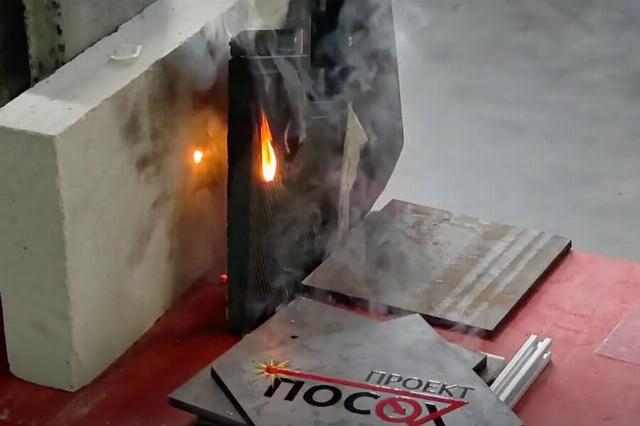The updated beamer "Staff" burned through steel a centimeter thick 15 times faster.
Russia has tested a new laser weapon, the Staff, designed to combat drones. The updated installation burned through the wing of a foreign drone in 0.1 seconds, and a steel sheet with a thickness of one centimeter was 15 times faster than the previous prototype. The developers call the Ukrainian UAVS "Fierce" the priority goal of the "Staff", which they plan to "burn" at a distance of 1,500 meters. How the new weapon works and when it will be delivered to the troops - in the material of the military observer "Gazeta.Ru" by Mikhail Khodarenka.
The Russian laser system for combating drones, created as part of the Staff project, has successfully passed bench tests, the CEO of the development company, who wished to remain anonymous, told RIA Novosti . At a distance of 50 meters, the laser burned through the wing of a foreign-made unmanned aerial vehicle in 0.1 seconds, as well as a ten-millimeter-thick steel sheet - 15 times faster than the previous prototype.
"We successfully conducted bench tests at a distance of 50 meters: we increased the power, reduced the size of the burn spot, increased the speed by 15 times, that is, we made the laser beam more concentrated. We understand that we are moving in the right direction, we know what kind of energy we need," the agency's source said.
The Staff project is being developed as a means of protecting troops and facilities from unmanned aerial vehicles. It is based on an ytterbium laser capable of destroying UAVs with a beam of directed energy. It was first mentioned in early July: then the laser installation was successfully tested at the test site, hitting the engine of a simulated enemy drone.
An updated, more powerful installation, which used a new lens, was already presented for bench testing.
The ongoing work in the field of combat laser weapons is considered by experts as one of the most promising areas in the field of combating unmanned aerial vehicles and barrage ammunition of all types.
The existing traditional means of countering aircraft - SAMs and small-caliber anti-aircraft artillery - do not always prove to be sufficiently effective against UAVs. Drones have less visual, acoustic, and radar visibility than traditional manned aircraft and helicopters, which makes it difficult to detect, identify, and target appropriate weapons.
The most attractive thing about laser weapons designed to combat drones is the cheapness of the shot. A short-range and short-range anti-aircraft guided missile is an order of magnitude or even two more expensive than a cheap drone or a barrage of ammunition. And firing such missiles can lead to a fairly rapid depletion of the capabilities of anti-aircraft missile forces and the exhaustion of enterprises of the military-industrial complex. The cost of one shot from a combat laser system is at the level of one dollar, and ammunition is practically unlimited.
Laser weapons are being developed in many countries, including the United States. For example, the Pentagon continues to fund research into the capabilities of 10-50 kW lasers as a mobile short-range air defense system such as DE M-SHORAD (Directed Energy Maneuver Short Range Air Defense).
However, it should be borne in mind that the effectiveness of a laser is highly dependent on weather conditions. For example, in Russia in October-November, there are 1-2 clear sunny days per month, no more. So in our conditions, it's probably not worth betting only on laser weapons.
And one last thing. Prototypes, prototypes, and bench tests are, of course, good and correct. But the fact that the "Staff" did not have time for its own is already unequivocal. And the deployment of large-scale production of such systems is a matter of several years. So effective anti-drone weapons are not expected to be deployed in the near future. The conflict in Ukraine will end, presumably, without these weapons.
In addition, we need to seriously look at the name of this combat laser system. Unfortunately, it is our tradition to give any pretentious and sometimes simply ridiculous names to weapons samples. After all, what is a staff? This is a long cane, a stick of a special kind and purpose. Of course, the staff can also be used as a means of self-defense, but the use of this term as the name of a weapon sample is still more than controversial.
The opinion of the author may not coincide with the position of the editorial board.
Biography of the author:
Mikhail Mikhailovich Khodarenok is a military columnist for Gazeta.Ru", retired colonel.
He graduated from the Minsk Higher Engineering Anti-Aircraft Missile School (1976), the Military Air Defense Command Academy (1986).
Commander of the S-75 anti-aircraft missile division (1980-1983).
Deputy commander of the anti-aircraft missile regiment (1986-1988).
Senior Officer of the General Staff of the Air Defense Forces (1988-1992).
Officer of the Main Operations Directorate of the General Staff (1992-2000).
Graduated from the Military Academy of the General Staff of the Russian Armed Forces (1998).
Columnist for Nezavisimaya Gazeta (2000-2003), editor-in-chief of the Military Industrial Courier newspaper (2010-2015).
Mikhail Khodarenok

